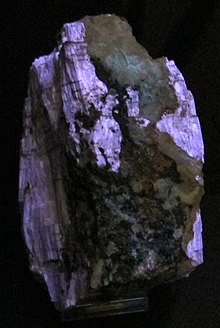| Agrellite | |
|---|---|
 Agrellite showing fluorescence in ultraviolet light Agrellite showing fluorescence in ultraviolet light | |
| General | |
| Category | Inosilicates |
| Formula (repeating unit) | NaCa2Si4O10F |
| IMA symbol | Are |
| Strunz classification | 9.DH.75 |
| Crystal system | Triclinic |
| Crystal class | Pinacoidal (1) (same H-M symbol) |
| Space group | P1 |
| Identification | |
| Color | White, grayish-white, greenish-white |
| Crystal habit | Lath - shaped like a small, thin plaster lath, rectangular in shape |
| Cleavage | perfect |
| Mohs scale hardness | 5.5 |
| Luster | pearly |
| Streak | white |
| Diaphaneity | translucent |
| Specific gravity | 2.88 |
| Optical properties | biaxial |
| Refractive index | nα = 1.567 nβ = 1.579 nγ = 1.581 |
| Birefringence | δ = 0.014 |
| References | |
Agrellite (NaCa2Si4O10F) is a rare triclinic inosilicate mineral with four-periodic single chains of silica tetrahedra.
It is a white to grey translucent mineral, with a pearly luster and white streak. It has a Mohs hardness of 5.5 and a specific gravity of 2.8. Its type locality is the Kipawa Alkaline Complex, Quebec, Canada, where it occurs as tabular laths in pegmatite lenses. Other localities include Murmansk Oblast, Russia, Dara-i-Pioz Glacier, Tajikistan, and Saima Complex, Liaoning, China. Common associates at the type locality include zircon, eudialyte, vlasovite, miserite, mosandrite-(Ce), and calcite.
Agrellite displays pink fluorescence strongly under shortwave and weakly under longwave ultraviolet light. The fluorescent activator is dominantly Mn, with minor Eu, Sm, and Dy.
It is named in honor of Stuart Olof Agrell (1913–1996), a British mineralogist at Cambridge University.
See also
References
- Warr, L.N. (2021). "IMA–CNMNC approved mineral symbols". Mineralogical Magazine. 85 (3): 291–320. Bibcode:2021MinM...85..291W. doi:10.1180/mgm.2021.43. S2CID 235729616.
- http://www.mindat.org/min-57.html Mindat
- http://www.webmineral.com/data/Agrellite.shtml Webmineral
- ^ "Agrellite". www.mindat.org. Retrieved 2021-12-08.
- "Handbook of Mineralogy". www.handbookofmineralogy.org. Retrieved 2021-12-08.
- ^ "Luminescence, fluorescence and phosphorescence of minerals". www.fluomin.org. Retrieved 2021-12-08.
This article about a specific silicate mineral is a stub. You can help Misplaced Pages by expanding it. |